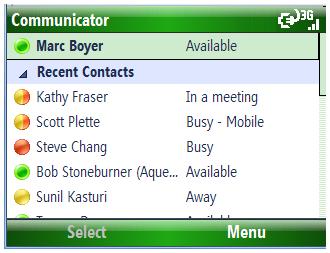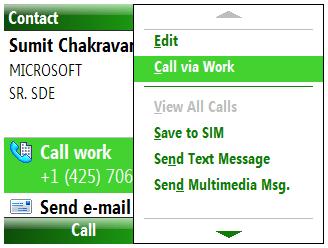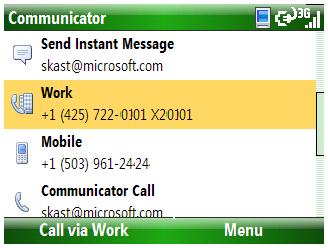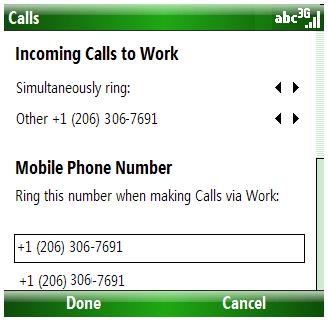Communicator goes Mobile
Communicator Mobile 2007 R2
Microsoft Office Communicator Mobile 2007 R2 is almost ready to be shipped to customers, so now is the perfect time to present this Microsoft Office Communications Server (OCS) client that makes it easy to stay connected from a mobile phone.
The Communicator Mobile project was conducted in parallel with the other OCS 2007 projects. The goal was to elevate mobile devices to first-class participants in Microsoft’s Unified Communications (UC) ecosystem. Thinking about the investments Microsoft made in voice, it made sense for us to have an OCS client on the mobile phone. We wanted this client to be a full UC endpoint, allowing the mobile phone to be the user’s only phone and a great complement to Microsoft Office Communicator.
When Communicator Mobile 2007 shipped last year, it had the necessary foundations that we needed to achieve our goal. It allowed a user to send and receive instant messages, receive and publish presence, and search for contacts in the enterprise’s address book. Shipping Communicator Mobile 2007 was exciting. We were anxiously awaiting the first customer feedback—after all, this is who we build products for. Users were happy with the ability to receive and send instant messages from the mobile phone and to update their presence on the road, but they asked for better battery life and the ability to receive and place phone calls through their enterprise OCS server. Both features had been on our minds from the beginning, and this feedback told us what to focus on for the next release Communicator Mobile.
Fast forward to the end of 2008: We are getting ready to release Communicator Mobile 2007 R2, which features more than 60% improvement in power consumption, single-number reach capabilities, plus various other tweaks and improvements that will make the mobile worker’s life better.
To reduce power consumption, we mainly focused on adapting the OCS presence model to a mobile device. The always pulling presence feature is a great solution for Communicator, but it wasn’t so great on a mobile device (rapid power consumption). On a mobile device, (which features limited screen real estate and only one visible application at a time), presence doesn’t need to be updated when Communicator Mobile is in the background. With this in mind, we designed a new presence model that prevents waking up the phone’s radio when it is not really needed. We also tied subscription packets to IM packets (to use the fact that radio is already active) and we suspended presence updates when the application is running in the background. At the same time, we improved the sign-in process to add some caching and significantly reduce sign-in time.
Because presence is essential to modern communication and because we had the goal of making a mobile client that is a first-class citizen of the UC world, we decided that Communicator Mobile will not only display presence but that it will also actively participate in the presence model.
When I am on the road, if I am connected on my mobile device, it is useful for my contacts to know this before contacting me; very often, for example, this helps people decide to use voice instead of IM, as they know I might be driving. Communicator Mobile 2007 R2 publishes a specific presence state that shows my presence as on a mobile device (I am available on mobile, or busy on mobile, etc…). It is also publishing my device capabilities, so I don’t receive application sharing invites, for example.
If Communicator Mobile is your only phone, it has to be able to receive calls that are arriving at your desk, and also it has to allow you to make outgoing calls via your work phone, even when you are away from your desk. All of this is part of our new client Single-number Reach feature. The first time you start Communicator Mobile, it does a basic check of your configuration in order to enable Enterprise Cellular Telephony (ECT) on your device. For example, Communicator Mobile determines whether you are UC enabled, or whether you have already set up any call-forwarding rules.) , With ECT, every call made to your desk phone (from another Communicator user or from any phone in the world) will automatically generate an “incoming call” notification on your Communicator Mobile phone.
From the message you can decline and send the call to your work voice mail (just like from Communicator). This allows you to have only once voice mail for all your work calls. If you decide to answer the call, it will look like you are taking the call from your desk, because Communicator Mobile IS your desk phone.
One Phone, One voice mail, Single Number Reach, a true Unified Communication statement.
Communicator Mobile 2007 R2 also allows you to place calls that are originated from your company phone, even when you are using your mobile phone on the other side of the continent. On your contact’s details cards, you now have an entry to place a call via work. Technically, Communicator Mobile is using the data connection to request your company’s OCS to place two calls, one to your contact one to yourself, and then merge the calls. The benefits are numerous: Your call appears as if it was originated from your company (useful when you do not want to disclose your location or your mobile phone number), and it allows you to call the other side of the world while being charged for a local call.
Call via Work from contact list
Call from Communicator UI
Communicator Mobile 2007 R2 also support for call handling setup. From your device, you can configure routing rules from your phone, to also ring your home phone, for example, or to pick up calls from your hotel room.
Communicator Mobile 2007 R2 works on Windows Mobile 6 (PocketPC or SmartPhone) with a minimum of 72 MB or ROM.
We also developed a Communicator Mobile 2007 R2 for Java. The application runs on mobile devices with 240 X 320 display size, MIDP 2.0, CLDC 1.1. It is supported on Nokia S40, 5th edition phones like 3120 Classic, 3600 Slide, 5220 XpressMusic , 5310 XpressMusic , 5610 XpressMusic, 6212 Classic, 6300i, 6301, 6500 Classic, 6500 Slide, 6600 Fold, 6600 Slide, 7210 Super Nova, 7310 Super Nova, 7510 Super Nova, 7610 Super Nova, 7900 Prism, 8800 Arte and Motorola Razr. Note: This version does not support call handling setup.
-Marc Boyer, Program Manager
Published Wednesday, November 26, 2008 2:26 PM by octeam
Filed Under: Communicator Mobile
Comments
Anonymous
November 18, 2012
Nice post. I used to be checking continuously this blog and I am inspired! Very useful information.I used to be seeking this particular info for a long time. Thank you and good luck. goo.gl/14rmOAnonymous
November 30, 2012
I have found that this article and Useful information. Overall, this is a good web site. Could anyone here show me where to find more detailed posts on this subject, I appreciated! http://goo.gl/iBx7bAnonymous
December 07, 2012
The Office Communicator 2007 is a very useful tool to use. I throughly enjoyed using it. Only issue i could encounter is after the meeting it is not reseting itself to available. Can any one resolve the issue, which will make it real time!! ThanksAnonymous
December 04, 2015
The comment has been removed





